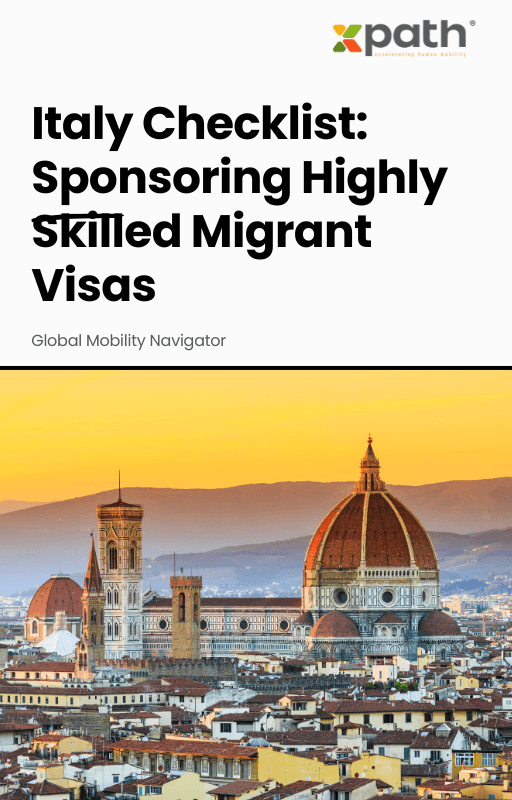Italy Checklist: Sponsoring Highly Skilled Migrant Visas
Grab a copy of a guide to international employee relocation
View E-book
Manage, track and optimize internal operations for increased efficiency of process workflow.
Gain dedicated consultants to manage your global mobility needs.
track and control assignment-related expenses for efficient budget management.
Gain insights and make informed decisions through this comprehensive feature.
Centralize expatriate information for efficient tracking, compliance, and editing.
Secure portals for uploading, storing, and managing necessary documents such as contracts, visas, and work permits.
Network of vetted suppliers offering over 60,000 mobility services across 183 countries.
track and control assignment-related expenses for efficient budget management.
Simplifies document requests and secure sharing for seamless collaboration for all stakeholders
Manage and streamline supplier deliverables for optimal performance and collaboration
Keep track of your assignment duration and length of stay in host country to support tax returns
Visa and Work Permit Processing
Comprehensive Support for Every Assignment Type
Short-Term & Long-Term Accommodations
Compliant Immigration and Visa Services
Assistance With Corporate Relocation Taxes & Social Security
Take control of your visa and immigration challenges today.
Ensure your departures are handled with care and precision.
Let our Advisory Services drive positive change in your organization.
Let us handle your immigration compliance needs while you focus on your core business.

HR
April 14, 2022 | xpath.global
When unexpected disruptions make business-as-usual impractical, it’s time to define the new normal and make it work for you. Whether it’s as a response to changing workforce expectations, the need to keep workers and society safe, or to support collaboration across teams spanning different geographic locations, many organizations today are looking at workplace flexibility in a new light. New ways of working often warrant new strategies, capabilities, behaviors, and mindsets to be successful.
Organizations should begin this process by gaining a firm understanding of the work that needs to be accomplished, what interactions are needed, and how customers are impacted. Mapping out collaboration and access requirements for the work will help determine what work in its current form can be accomplished in remote/virtual environments — and what work cannot. Workers directly involved with the work and related processes are best equipped to provide insights into collaboration requirements and accessibility needs.
Workforce experience is key to a human-centered approach and needs to be at the forefront in the remote workplace. A holistic workforce experience prioritizes worker wellbeing and is anchored by core behaviors such as inclusivity, trust, and humanity. Organizations should prioritize workforce wellbeing and take an inclusive approach to work flexibility, offering options that meet a variety of diverse needs.
Leaders play a critical role in catalyzing change within an organization. Resources and technologies can assist them in developing compelling relationships and facilitating collaboration in virtual environments. Creating a remote/virtual workplace doesn’t mean moving away from in-person interactions; rather, it involves thinking of new ways to personalize interactions in a separate environment. Optimizing and personalizing meetings is a powerful means to build an engaging, human-centered experience. For instance, leveraging video during virtual meetings is as close to a personal, face-to-face interaction as possible in a remote setup. The following chart outlines tips for creating successful virtual meetings.
High-performing organizations are 15 times more likely than low-performing organizations to use data to inform workplace decisions. This data can be sourced from within the organization (e.g., human resources information systems, employee survey data, operational work systems) and from outside (e.g., customer requirements, broader talent market trends, or data about the remote potential for jobs). Organizations should use different types of data to help them determine what needs to change, start small, experiment with different workplace options, and then iterate and scale those changes gradually.
As organizations progress through the above areas, they should also take a moment to view the workplace holistically—as more than just the traditional physical office. Organizations can drive even more value from remote/virtual work. Empowerment and flexibility within current roles can open doors for the workforce to discover new ways to use nontraditional work environments to deliver greater impact and value.
Incorporating insights from the coaching industry can provide valuable perspectives on enhancing workplace flexibility. Coaching strategies can help individuals and teams navigate the transition to remote work more effectively, improving their ability to adapt and thrive in a virtual environment. Coaches can assist in developing new mindsets and behaviors essential for successful remote work.
Building resilience is critical for adapting to the new normal. Organizations should focus on strategies that foster resilience among their employees, helping them manage stress and maintain productivity in a flexible work environment. The coaching industry offers techniques and frameworks that can support workforce resilience, making it easier for employees to cope with changes and challenges.
Effective communication and collaboration tools are vital for a successful virtual workplace. Investing in and utilizing advanced tools can enhance connectivity and ensure seamless interaction among team members.
Previous article

Italy Checklist: Sponsoring Highly Skilled Migrant Visas
Grab a copy of a guide to international employee relocation
View E-book
